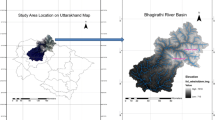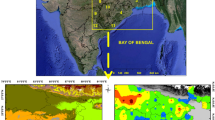Abstract
Climate model simulations for the twenty-first century point toward changing characteristics of precipitation. This paper investigates the impact of climate change on precipitation in the Kansabati River basin in India. A downscaling method, based on Bayesian Neural Network (BNN), is applied to project precipitation generated from six Global Climate Models (GCMs) using two scenarios (A2 and B2). Wet and dry spell properties of monthly precipitation series at five meteorologic stations in the Kansabati basin are examined by plotting successive wet and dry durations (in months) against their number of occurrences on a double-logarithmic paper. Straight-line relationships on such graphs show that power laws govern the pattern of successive persistent wet and dry monthly spells. Comparison of power-law behaviors provides useful interpretation about the temporal precipitation pattern. The impact of low-frequency precipitation variability on the characteristics of wet and dry spells is also evaluated using continuous wavelet transforms. It is found that inter-annual cycles play an important role in the formation of wet and dry spells.








Similar content being viewed by others
References
Bàrdossy A, Stehlìk J, Caspary HJ (2002) Automated objective classification of daily circulation patterns for precipitation and temperature downscaling based on optimized fuzzy rules. Clim Res 23:11–22
Bàrdossy A, Bogardi I, Matyasovszky I (2005) Fuzzy rule-based downscaling of precipitation. Theor Appl Climatol 82:119–129
Benestad RE (2004) Empirical-statistical downscaling in climate modeling. EOS 85(42):417
Bishop C (1995) Neural network for pattern recognition. Oxford University Press, New York
Cannon AJ, Whitfield PH (2002) Downscaling recent streamflow conditions in British Columbia, Canada using ensemble neural network models. J Hydrol 259:136–151
Coulibaly P, Dibike YB (2005) Downscaling precipitation and temperature with temporal neural networks. J Hydrometeorol 6:483–495
Dhar S, Majumdar A (2009) Hydrological modelling of the Kangsabati River under changed climate scenario: case study in India. Hydrol Process 23:2394–2406
Dibike YB, Coulibaly P (2006) Temporal neural networks for downscaling climate variability and extremes. Neural Netw 19:135–144
Farge M (1992) Wavelet transforms and their applications to turbulence. Annu Rev Fluid Mech 24:395–457
Fowler HJ, Kilsby CG, O’Connell PE (2000) A stochastic rainfall model for the assessment of regional water resource systems under changed climatic conditions. Hydrol Earth Syst Sci 4:261–280
Fowler HJ, Kilsby CG, O’Connell PE, Burton A (2005) A weathertype conditioned multi-site stochastic rainfall model for generation of scenarios of climatic variability and change. J Hydrol 3081(4):50–66
Fowler HJ, Blenkinsop S, Tebaldi C (2007) Linking climate change modelling to impacts studies: recent advances in downscaling techniques for hydrological modeling. Int J Climatol 27:1547–1578
Fritz SC (1996) Paleolimnological records of climate change in North America. Limnol Oceanogr 41(5):882–889
Goodess CM, Palutikof J (1998) Development of daily rainfall scenarios for southeast Spain using a circulation-type approach to downscaling. Int J Climatol 18:1051–1083
Grinsted A, Moore JC, Jevrejeva S (2004) Application of the cross wavelet transform and wavelet coherence to geophysical time series. Nonlinear Proc Geophys 11:561–566
Hughes JP, Guttorp P (1994) A class of stochastic models for relating synoptic atmospheric patterns to regional hydrologic phenomena. Water Resour Res 305:1535–1546
Huth R (1999) Statistical downscaling in central Europe: evaluation of methods and potential predictors. Clim Res 13:91–101
Huth R (2004) Sensitivity of local daily temperature change estimates to the selection of downscaling models and predictors. J Clim 17:640–652
Ines AVM, Hansen JW (2006) Bias correction of daily GCM rainfall for crop simulation studies. Agric For Meteorol 138:44–53
IPCC (2000) IPCC special report on emission scenarios, Working group III of the Intergovernmental Panel on Climate Change. Cambridge University Press: Cambridge, 599 pp, ISBN: 92-9169-113-5
IPCC (2008) Climate change and water, Intergovernmental Panel on Climate Change. Technical Paper VI
Kadioglu M, Sen Z (1998) Power–law relationship in describing temporal and spatial precipitation pattern in Turkey. Theor Appl Climatol 59:93–106
Keller CF (2009) Global warming: a review of this mostly settled issue. Stoch Environ Res Risk Assess 23:643–676
Khan MS, Coulibaly P (2006) Bayesian neural network for rainfall-runoff modeling. Water Resour Res 42:W07409. doi:10.1029/2005WR003971
MacKay DJC (1992a) The evidence framework applied to classification networks. Neural Comput 45:720–736
MacKay DJC (1992b) Bayesian methods for adaptive models. PhD thesis, Computation and Neural Systems, California Institute of Technology, Pasadena, CA
MacKay DJC (2003) Information theory, inference, and learning algorithms. Cambridge University Press, Cambridge
Mishra AK, Singh VP (2009) Analysis of drought severity-area-frequency curves using a general circulation model and scenario uncertainty. J Geophys Res 114:D06120. doi:10.1029/2008JD010986
Mishra AK, Desai VR, Singh VP (2007) Drought forecasting using a hybrid stochastic and neural network model. J Hydrol Eng 12(6):626–638
Mishra AK, Ozger M, Singh VP (2009) Trend and persistence of precipitation under climate change scenarios for Kansabati basin, India. Hydrol Process 23:2345–2357
Nabney IT (2004) Netlab algorithms for pattern recognition. Springer, New York
Neal RM (1996) Bayesian learning for neural networks, Lecture notes in statistics, vol 118. Springer, New York
Prudhomme C, Jakob D, Svensson C (2003) Uncertainty and climate change impact on the flood regime of small UK catchments. J Hydrol 277:1–23
Schubert S (1998) Downscaling local extreme temperature changes in south-eastern Australia from the CSIRO Mark2 GCM. Int J Climatol 18:1419–1438
Sen Z, Altunkaynak A, Ozger M (2003) Autorun persistence of hydrologic design. J Hydrol Eng 8:329–338
Shannon CE (1948) A mathematical theory of communication. Bell Syst Tech J 27(379–423):623–656
Singh VP (1997) The use of entropy in hydrology and water resources. Hydrol Process 11:587–626
Suhaila J, Jemain AA (2009) Investigating the impacts of adjoining wet days on the distribution of daily rainfall amounts in Peninsular Malaysia. J Hydrol 368(1–4):17–25
Tito EH, Zaverucha G, Vellasco MMBR, Pacheco M (1999) Applying Bayesian neural networks to electrical load forecasting. In: Proceedings of the sixth international conference on neural information processing, ICONIP’99, Perth, Australia
Torrence C, Compo GP (1998) A practical guide to wavelet analysis. Bull Am Meteorol Soc 79:61–78
Torrence C, Webster PJ (1999) Interdecadal changes in the ENSOmonsoon system. J Clim 12:2679–2690
Unal NE, Aksoy H, Akar T (2004) Annual and monthly rainfall data generation schemes. Stoch Environ Res Risk Assess 18:245–257
von Storch H, Zwiers F (1999) Statistical analysis in climate research. Cambridge University Press, Cambridge
Wilby RL, Wigley TML (1997) Downscaling general circulation model output: a review of methods and limitations. Prog Phys Geogr 21:530–548
Wilby RL, Wigley TML, Conway D, Jones PD, Hewitson BC, Main J, Wilks DS (1998) Statistical downscaling of general circulation model output: a comparison of methods. Water Resour Res 34:2995–3008
Wilby RL, Hay LE, Leavesly GH (1999) A comparison of downscaled and raw GCM output: implications for climate change scenarios in the San Juan river basin, Colorado. J Hydrol 225:67–91
Wood AW, Maurer EP, Kumar A, Lettenmaier DP (2002) Long-range experimental hydrologic forecasting for the eastern United States. J Geophys Res 107(D20):4429
Acknowledgment
The authors wish to thank Bellie Sivakumar and two reviewers for their useful suggestions that helped to improve the quality of the manuscript.
Author information
Authors and Affiliations
Corresponding author
Rights and permissions
About this article
Cite this article
Mishra, A.K., Özger, M. & Singh, V.P. Wet and dry spell analysis of Global Climate Model-generated precipitation using power laws and wavelet transforms. Stoch Environ Res Risk Assess 25, 517–535 (2011). https://doi.org/10.1007/s00477-010-0419-7
Published:
Issue Date:
DOI: https://doi.org/10.1007/s00477-010-0419-7




